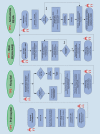[Tyrolean stroke pathway]
- PMID: 35464755
- PMCID: PMC9012438
- DOI: 10.1007/s10049-022-01016-w
[Tyrolean stroke pathway]
Abstract
Background: Recent advances in acute stroke therapy have been shown to improve clinical outcome and therefore reduce long-term disability. Acute therapy procedures in stroke have a limited time frame after onset of symptoms; thus, rapid emergency management is critical. The Tyrolean Stroke Pathway was developed to optimize the entire treatment pathway from stroke onset to outpatient rehabilitation.
Objectives: The description of the Tyrolean Stroke Pathway as an example to optimize the entire treatment pathway of stroke patients in a central European alpine region with a focus on prehospital management.
Materials and methods: In four subprojects from the prehospital phase up to outpatient rehabilitation, the project optimized intersections between different phases of care and evaluated the care processes using quality assurance measures.
Results: After implementation, thrombolysis rates doubled and functional outcome of stroke patients after 3 months improved and complications, e.g., pneumonia, declined. Access to rehabilitation improved, particularly because of the establishment of quality assured and funded outpatient rehabilitation.
Conclusions: The project showed that a holistic standardized stroke pathway from acute management up to outpatient rehabilitation can be successfully implemented in clinical routine. The project improved the entire health care pathway of stroke patients. The Stroke Action Plan for Europe 2018-2030 recommends to have national plans for stroke that encompass the entire chain of care.
Hintergrund: In der Behandlung des Schlaganfalls gibt es Fortschritte auf vielen Ebenen. Dies führt zu besseren Heilungschancen und einer Minderung körperlicher Beeinträchtigung. Akuttherapiemaßnahmen sind auf ein kurzes Zeitfenster nach Auftreten limitiert, deshalb ist das Notfallmanagement besonders kritisch. Das Projekt Schlaganfallpfad Tirol wurde realisiert, um die Versorgungskette beim Krankheitsbild Schlaganfall von der prähospitalen Phase bis zum Abschluss der Rehabilitation zu optimieren.
Ziel der Arbeit: Beschreibung des Tiroler Schlaganfallpfads als Beispiel für die Optimierung der Schlaganfallversorgung in einer mitteleuropäischen alpinen Region mit Schwerpunkt auf die prähospitale Versorgung.
Material und Methoden: In vier Teilprojekten von der Prähospitalphase bis zur Nachbehandlung wurden Versorgungsprozesse und Schnittstellen optimiert und mit Qualitätssicherungsmaßnahmen evaluiert.
Ergebnisse: Nach Implementierung hat sich die Thrombolyserate fast verdoppelt und die Rate an gutem funktionellem Outcome nach 3 Monaten verbessert. Komplikationen wie eine Aspirationspneumonie haben deutlich abgenommen. Der Zugang zu rehabilitativen Maßnahmen hat sich verbessert, insbesondere auch wegen des Aufbaus einer qualitätskontrollierten und finanzierten ambulanten Rehabilitation.
Schlussfolgerung: Ein ganzheitliches Versorgungsprojekt kann gut in die Praxis umgesetzt werden und verbessert die Versorgungsqualität beim ischämischen Schlaganfall. Der europäische Aktionsplan Schlaganfall 2018–2030 empfiehlt die Etablierung umfassender Schlaganfallpfade in allen Regionen und Ländern Europas.
Keywords: Care pathway; Emergency treatment/stroke; Prehospital emergency care; Quality of health care; Rescue chain.
© The Author(s) 2022.
References
-
- https://schlaganfallpfad.tirol-kliniken.at/pdfs/Integrierter_Patientenpf.... Zugegriffen: 26. Juli 2021
-
- Krebs S, Roth D, Knoflach M, et al. Design and derivation of the Austrian prehospital stroke scale (APSS) to predict severe stroke with large vessel occlusion. Prehosp Emerg Care. 2021;12:1–9. - PubMed
Publication types
LinkOut - more resources
Full Text Sources




